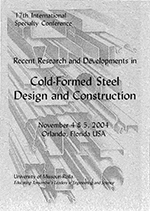Session Dates
04 Nov 2004 - 05 Nov 2004
Abstract
Current cold-formed stainless steel design codes for distortional buckling, including the Australian/New Zealand Standard AS/NZS 4673 (2001) and the North American ASCE (2002), have been based on cold-formed carbon steel codes without the support or corroboration of experimental evidence. As such, an experimental program on the distortional buckling of axially compressed, cold-formed stainless steel simple lipped channels and lipped channels with intermediate stiffeners was conducted. Results show that the effect of stainless steel material non-linearity is partially negated by the strength-enhanced corners, and this becomes evident in the design evaluation. Both the effective width and the "direct strength" (ASINZS 4600 1996) design approaches are considered. When the enhanced corner properties are ignored, the effective width design evaluation may become unconservative for sections with a corner area less than 10% of the gross area and become overly conservative for sections with a corner area greater than approximately 10% of the gross area. The "direct strength" evaluation provides reasonably conservatively strength predictions for sections with a corner area of at least 10% of the gross area, provided enhanced corners are ignored and the (actual) fixed end conditions are modeled in the elastic buckling analysis.
Department(s)
Civil, Architectural and Environmental Engineering
Research Center/Lab(s)
Wei-Wen Yu Center for Cold-Formed Steel Structures
Meeting Name
17th International Specialty Conference on Cold-Formed Steel Structures
Publisher
University of Missouri--Rolla
Document Version
Final Version
Rights
© 2004 University of Missouri--Rolla, All rights reserved.
Document Type
Article - Conference proceedings
File Type
text
Language
English
Recommended Citation
Leece, Maura and Rasmussen, Kim J. R., "Design of Stainless Steel Sections Against Distortional Buckling" (2004). CCFSS Proceedings of International Specialty Conference on Cold-Formed Steel Structures (1971 - 2018). 2.
https://scholarsmine.mst.edu/isccss/17iccfss/17iccfss-session5/2
Design of Stainless Steel Sections Against Distortional Buckling
Current cold-formed stainless steel design codes for distortional buckling, including the Australian/New Zealand Standard AS/NZS 4673 (2001) and the North American ASCE (2002), have been based on cold-formed carbon steel codes without the support or corroboration of experimental evidence. As such, an experimental program on the distortional buckling of axially compressed, cold-formed stainless steel simple lipped channels and lipped channels with intermediate stiffeners was conducted. Results show that the effect of stainless steel material non-linearity is partially negated by the strength-enhanced corners, and this becomes evident in the design evaluation. Both the effective width and the "direct strength" (ASINZS 4600 1996) design approaches are considered. When the enhanced corner properties are ignored, the effective width design evaluation may become unconservative for sections with a corner area less than 10% of the gross area and become overly conservative for sections with a corner area greater than approximately 10% of the gross area. The "direct strength" evaluation provides reasonably conservatively strength predictions for sections with a corner area of at least 10% of the gross area, provided enhanced corners are ignored and the (actual) fixed end conditions are modeled in the elastic buckling analysis.



